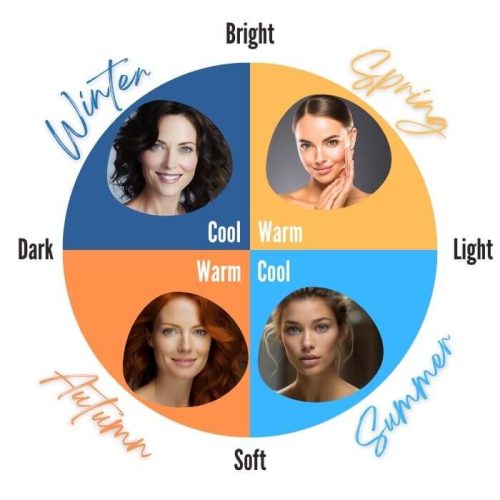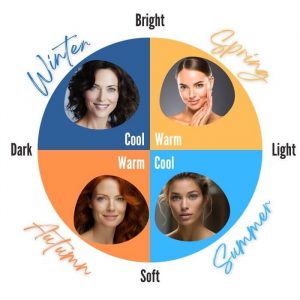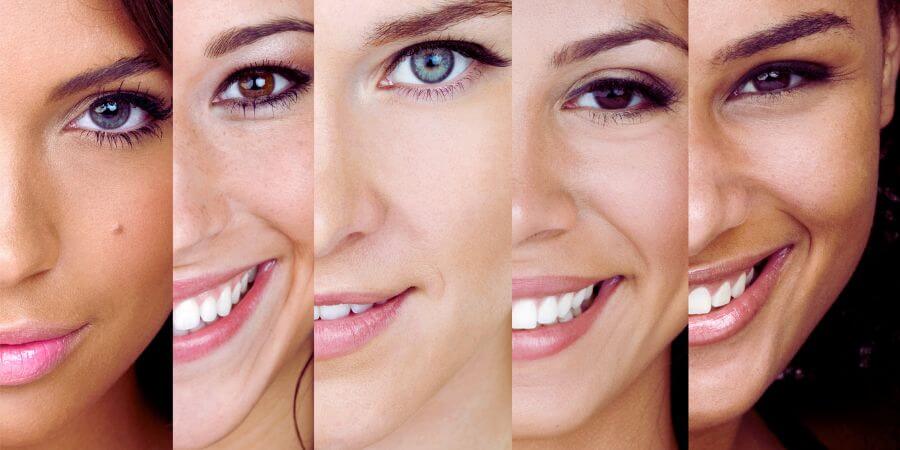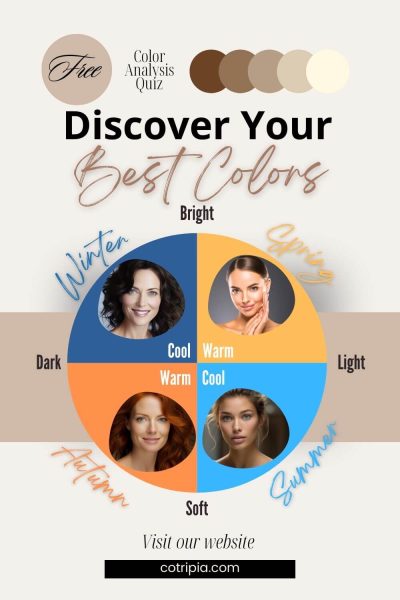Color plays a significant role in defining our personal style, enhancing our features, and expressing our individuality. Understanding the colors that complement your skin tone can revolutionize your wardrobe, making every outfit a confident and stylish choice. The first thing to start with when forming your wardrobe is to make your color analysis test. The basics of the color analysis are based on four seasons: winter, spring, summer, and autumn. To determine a color type, it is possible to look at your skin pigment, eye color, and hair color.
In this comprehensive guide, we’ll explore the world of DIY color analysis for your wardrobe, helping you unlock the secrets to a palette that perfectly suits you.
1. Understanding Color Analysis: The Basics
color analysis involves identifying the undertones of your skin and determining the colors that harmonize with those undertones. Undertones fall into three main categories: cool, warm, and neutral.
1. Cool Undertones:
- Veins on the wrist appear more blue.
- Silver jewelry complements your skin.
- Your skin may have hints of pink or blue.
2. Warm Undertones:
- Veins on the wrist appear more green.
- Gold jewelry complements your skin.
- Your skin may have hints of yellow, peach, or gold.
3. Neutral Undertones:
- Veins on the wrist appear both blue and green.
- Both silver and gold jewelry may complement your skin.
- Your skin has a balance of warm and cool tones.

2. Starting without makeup in natural light is key.
Identify your dominant characteristic.
- Deep: Embrace strong, rich, dark coloring.
- Light: Reflect a very light and delicate aura.
- Warm: Favor yellow-based colors without blue undertones.
- Cool: Opt for blue-based colors, avoiding yellow or golden undertones.
- Clear: Shine in bright, clear colors; avoid muted or dusty tones.
- Muted: Choose soft, dusty colors; avoid bright, overpowering hues; often neutral in temperature and saturation.
3. DIY Color Analysis Steps: Unlocking Your Palette
1. Check Your Veins:
- Examine the veins on your wrist in natural light. If they appear more blue, you likely have cool undertones. If they appear more green, warm undertones are probable. If they look both blue and green, you may have neutral undertones.
2. Jewelry Test:
- Try on silver and gold jewelry separately and observe which complements your skin tone better. Cool undertones often pair well with silver, while warm undertones shine with gold. Neutral undertones can pull off both.
3. Assess Your Natural Hair Color:
- The color of your natural hair can provide clues about your undertones. Cooler undertones may have hair with ashy tones, while warmer undertones may have hints of red or gold. Neutral undertones may showcase a mix.
4. White vs. Cream Test:
- Place a white and a cream-colored fabric near your face. If white is more flattering, you may have cool undertones. If cream looks better, warm undertones are likely. If both look good, neutral undertones could be the key.
5. The Sun Test:
- Observe how your skin reacts to sun exposure. If you tend to burn easily and have a cooler complexion, you may have cool undertones. If you tan more readily and have a warmer complexion, warm undertones are probable.
6. Assess Your Favorite Colors:
- Reflect on the colors you naturally gravitate toward. If you often choose blues, purples, and cool tones, you may have cool undertones. If you prefer warm colors like reds, oranges, and earthy tones, warm undertones could be predominant.
Get a FREE Color Analysis Quiz!
Begin crafting your wardrobe and makeup by taking this 5-question color analysis test.
4. Unlocking Your Color Palette: Cool, Warm, or Neutral?
1. Cool Color Palette:
- Cool Undertones: If you have cool undertones, colors like blues, purples, pinks, and cool greens will complement your skin. Opt for eyeshadows, lipsticks, and blushes in these shades for a harmonious look.
- Consider jewel tones for a vibrant and flattering look.
2. Warm Color Palette:
- Warm Undertones: If you have warm undertones, earthy tones such as reds, oranges, yellows, and warm browns will enhance your complexion. Embrace autumnal hues for a cozy and appealing palette.
- Experiment with warm hues for eyeshadows, lip colors, and blushes.
3. Neutral Color Palette:
- Neutral Undertones: Lucky you! With neutral undertones, you can pull off a versatile range of colors. Explore both cool and warm tones, including muted shades, pastels, and earthy neutrals. The beauty of neutral undertones is the versatility they offer, including muted shades, pastels, and earthy neutrals, for a well-rounded makeup palette.


Get a FREE Color Analysis Quiz
Discover the power of color to accentuate your appearance.
5. Building Your Personalized Makeup Collection
1. Foundation and Concealer:
- Choose foundation and concealer shades that align with your undertones. This ensures a seamless and natural finish that enhances your complexion.
2. Eyeshadows:
- Experiment with eyeshadows in your chosen color palette. Cool undertones may gravitate towards blues and purples, while warm undertones can explore reds and golds.
3. Lip Colors:
- Select lip colors that complement your undertones. Cool undertones can embrace pinks and berries, while warm undertones can indulge in warm reds and corals.
4. Blushes:
- Blushes in shades of cool pinks or warm peaches can add a healthy flush to your cheeks. Choose tones that resonate with your overall color analysis.
5. Experiment with Trends:
- While sticking to your personalized palette, feel free to experiment with trendy colors in small doses. Incorporate them into your makeup routine to stay fashion-forward.
6. Conclusion
Embarking on a DIY color analysis journey for your wardrobe is like unlocking a personalized palette that celebrates your unique beauty. Understanding your undertones empowers you to make informed choices, curate a wardrobe that speaks to your individuality, and step confidently into a world of colors that enhance your natural radiance. So, embrace the art of color analysis, paint your wardrobe canvas with intention, and revel in the joy of expressing your authentic style to the world.

7. Frequently Asked Questions (FAQs)
1. Can my undertones change over time?
- While the overall undertones of your skin tend to remain consistent, factors like sun exposure and aging can influence how your skin appears. It’s advisable to periodically reassess your undertones, especially if there have been significant changes.
2. What if I have a mix of warm and cool undertones in different areas of my face?
- This could indicate neutral undertones. If you observe a balance of warm and cool tones on different parts of your face, you may fall into the neutral category, allowing you to explore a broad spectrum of colors.
3. Can I wear colors outside my determined palette?
- Absolutely! While your determined palette enhances your features, fashion is also about personal expression. Feel free to experiment with a variety of colors, textures, and patterns to discover what resonates with your style and mood.
4. How often should I reassess my color analysis?
- It’s advisable to reassess your color analysis if you notice significant changes in your skin tone, hair color, or overall appearance. As a general guideline, consider reassessing every few years or when you undergo notable lifestyle changes.
5. Can I wear black or white if it’s not in my determined palette?
- While black and white are considered neutral, they can have cool or warm undertones. If they are not in your determined palette, consider experimenting with different shades or incorporating them in small doses through accessories.
6. Do I have to stick to one color palette exclusively?
- No, you have the flexibility to blend colors from different palettes based on your preferences. The suggested palettes provide guidance, but personal style often involves mixing and matching to create a unique and personalized look.
7. Can I use online tools for color analysis?
- Online tools and quizzes can provide a general idea, but they may not be as accurate as an in-person analysis. If possible, consult with a professional color analyst for a more precise assessment.
8. How do I incorporate trends into my color palette?
- Trends often introduce new colors and patterns. Evaluate how these trends align with your determined palette and consider incorporating them through accessories or statement pieces to stay fashion-forward without deviating from your overall color scheme.
9. Are there specific color rules for different body types?
- The principles of color analysis focus on enhancing individual features rather than body types. However, choosing colors that complement your undertones can create a harmonious and flattering overall look.
10. Can I wear pastels if I have warm undertones?
- Pastels can work for warm undertones, but it’s essential to choose warm pastels like peach, coral, or warm pinks. Experiment with different shades within the pastel spectrum to find what complements your skin tone best.
Recommended for You
Free Tool iVisa: Check Travel Requirements in Secs Explore the...
Author

Cotripia is your gateway to elevated travel. We serve as your portal to the world of stylish travel, exquisite beauty products, luggage, and all the vital travel essentials. Furthermore, we provide an array of valuable resources, including expertly crafted packing guides, meticulous checklists, insider tips, enlightening ebooks, and much more.
View all posts






